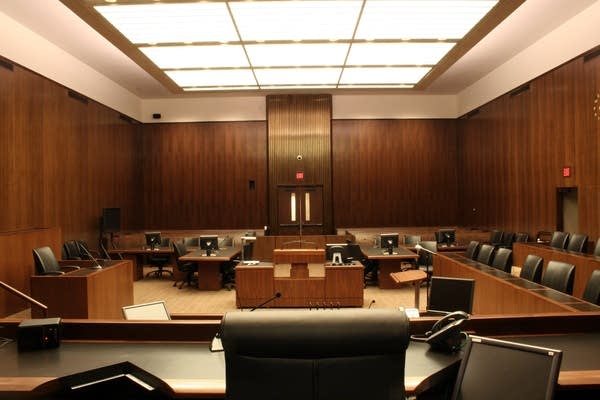Federal courthouse reopens after three-year, $65 million renovation

Named after the former chief justice of the U.S. Supreme Court and St. Paul native, the Warren Burger Federal Courthouse was built in 1966. The architect on the recent project, Richard Gilyard, said the renovation posed a number of challenges.
"I think we all agreed that this building had very good bones," Gilyard said. "And the special spaces, like the courtrooms, were very well done. So how do you bring up the rest of the building to the level of quality and design that the courtrooms had from the start?"

In addition, he said the renovation had to balance the feeling that the courthouse is a public building and the need to keep the courthouse open to the public, while also keeping people safe.
"There is the security and so on, but how do you give it a sense of openness and light and understandability?" Gilyard said. "A part of that then, was opening up much more of the front, taking off the heavy canopy, putting much more glass here so that we're washing the whole lobby with much more light."
Create a More Connected Minnesota
MPR News is your trusted resource for the news you need. With your support, MPR News brings accessible, courageous journalism and authentic conversation to everyone - free of paywalls and barriers. Your gift makes a difference.
The public still will likely never see many of the security improvements. The most expensive part of the project were the holding cells. All of the equipment is stainless steel. The cells have reinforced block walls and camera monitors wired back to the command center.
Before the renovation, U.S. marshals brought prisoners in for their court hearings or trials through a general parking area, the same area that judges like Senior Judge Richard Kyle parked.

"Nothing ever happened to me, but I would come out to get in my car and there'd be 11 people in handcuffs coming by," Kyle said. "And so now we have a whole new system where they're coming in by themselves, into a secure hallway, and threaded two new elevators just for prisoners."
Kyle said even though no one ever escaped in the past, the new arrangement means better security for everyone.
Before the remodeling project, the court was only one of several tenants in the building, which meant high numbers of people moved around all seven floors of the building.

Now, high traffic areas like the clerk of courts office, which keeps legal records, are now on the first floor. So is the jury assembly room and the largest courtroom. The idea is that there will be fewer people moving around on the floors containing the other courtrooms and judges' chambers.
As part of the renovation, the court added four courtrooms, complete with walnut veneer on some of the walls, and redesigned the layout of the other courtrooms. One of the biggest differences visitors will notice is that the witness chair is no longer right next to the judge.
To get a sense of how the courtrooms are now set up, consider thinking about it like the numbers on a clock. The judge is at 12 o'clock, the witness chair is now at 3 o'clock, the attorney's podium is at 6 o'clock and the jury box is at 9 o'clock.

Judge Kyle said in nearly every trial, attorneys need to show documents or videos to the jury on a big screen far away from the testifying witness.
"While they're looking at the document, the witness is talking, so they're forced to go back and forth all the time. They don't know what the witness' expression is when the witness first sees the document," Kyle said. "This means right now that every juror has a clear view."
Under the new system, the screen for showing documents is slightly behind and above the witness, so jurors can easily see both at the same time.
Visitors will also notice that there are still two access points to the courthouse, the front and at skyway level. The difference now is that the skyway level will funnel visitors down to the main floor for security.
Court staff moved in last week and visitors may notice that not everything is yet in its proper place. But after three years of working in a temporary building, the judges and others who work in the courthouse said they're glad to be back home.


